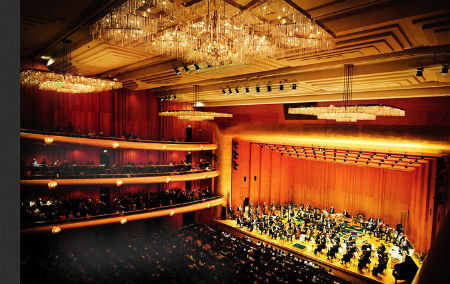Despite a budget of only $21 million, the Utah Symphony/Utah Opera has wide-ranging economic impacts, including enhancing the area’s ability to attract companies and skilled workers.
Despite a budget of only $21 million, the Utah Symphony/Utah Opera has wide-ranging economic impacts, including enhancing the area’s ability to attract companies and skilled workers.
That’s the conclusion of Patricia Richards, interim president and chief executive officer of the Utah Symphony/Utah Opera, who recently explained during a Governor’s Office of Economic Development (GOED) board meeting the economic wallop that the performing arts have on the Wasatch Front.
For example, of the $21 million in the budget for Utah Symphony/Utah Opera and the Deer Valley Music Festival, 93 percent is spent in the local community. And the multiplier effect of people spending money to attend events calculates to $45.5 million in consumer spending.
“So this is, I think, a huge impact on our community,” Richards said, noting that more than 350,000 people attend the events each year.
“There’s clearly something going on here that’s very important to our community. I think that I’ve heard it said that you cannot be a great city without a great orchestra, but I think certainly arts are essential to every great city — the quality of life, the economic vitality and the training of creative minds.”
Regarding economic vitality, Richards cited a recent study that indicates that having high-quality arts organizations enables a community to better attract “knowledge workers.” The study considered 188 metro areas with at least one symphony orchestra, opera or ballet company. The difference between areas without one of those and areas with one totaled $60 billion in annual income and 1.5 million jobs.
“Interestingly enough, the more arts that community had, the more their competitive advantage, so that if they had all three of the symphony, opera and ballet company, their competitive advantage was twice that of cities that had only one,” Richards said.
The Salt Lake City incremental impact by having the Utah Symphony, Utah Opera and Ballet West was calculated at 3,600 knowledge-class jobs, $230 million in employment income and an overall economic impact of $1.3 million.
“Part of our vision is not just to be a great performing arts organization but to use that to bring a visibility to the state of Utah. … I think this is just an important part of our ability to attract businesses, professionals and executives to our state,” Richards said.
“It’s something that’s an amenity that they expect. It’s [available] where they came from and they want to have it here for themselves and their families.”
A less-tangible connection between the arts and economic vitality involves arts’ importance “in the wiring of young minds,” Richards told the board. “This is where innovation comes from. This is where creativity comes from. This is where you get the thinkers, the dreamers, the visionaries.
“I totally believe in the value of arts education in our society, so I would ask you please to support it with policy, with funding and with participation.”
Richards also said she hopes to get more contributions from Utah corporations to support the Utah Symphony/Utah Opera. Of its 2014-15 revenue budget, 46 percent, or $9.4 million, came from contributions, but of that total, only $1.5 million came from corporations.
“The trend in corporate giving to communities has been drastically down — down about 25 percent over the last 10 years — and that is really impacting the arts. In particular it’s a challenge to the diversification of our revenue sources and I would actually like to challenge corporations in this community — realizing that it’s in their self-interest, that it’s actually important to economic development — to consider a greater participation in supporting and funding the arts in our community,” she said.
The Utah Symphony/Utah Opera, merged in 2002, includes one of only 15 full-time orchestras in the U.S. Overall, it has more than 310 artists and more than 400 volunteers. Its facilities include Abravanel Hall, the Janet Quinney Lawson Capitol Theatre and Utah Operation Production Studios.
The organization is involved in more than 330 performances each year. They include 36 concerts, 20 Utah Opera performances, 21 entertainment and special event concerts, 30-plus community concerts and 22 Deer Valley Music Festival concerts. More than 200 free shows take place in schools, reaching 145,000 students annually.








